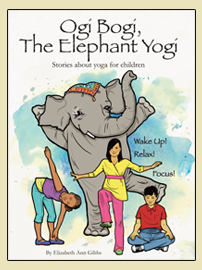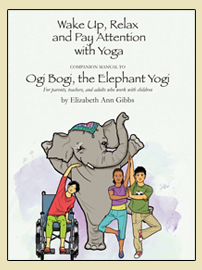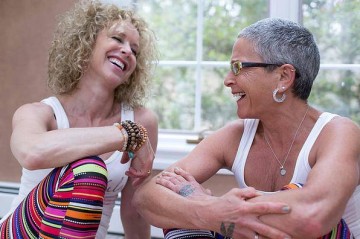In this issue, we review several new books that are important in the field of yoga and mental health. Guest LifeForce Yoga Practitioner reviewers Anne Friedenheim, Ellen Campbell, and Sherry Rubin reviewed books by Rama Jyoti Vernon, the master yoga teacher, who has finally graced us with the wisdom of her many years of study and practice, Beth Gibbs, a senior teacher trainer in the Integrative Yoga Therapy Training Program, who writes two books—one for young children, and the other a manual for those who love them, and psychologist and meditation teacher Elisha Goldstein. I am honored to review the new book by Richard Miller, who despite his years of scholarship, clinical work and the depth of his study in yoga, writes an accessible meditation manual for those who have experienced trauma. Read the reviews, the books themselves, and then make time to play!
Review: The iRest Program for Healing PTSD by Richard Miller, PhD
 Here psychologist and master yoga and meditation teacher Richard Miller shares the “open secret” of a practice that in 1970 expanded his sense of ease and at-oneness with the world as it is. From that first encounter at the end of a yoga class, Miller understood that his life would include yoga nidra. As a yoga scholar, researcher and teacher, he has blazed a trail, introducing yoga nidra, renamed Integrative Restoration (iRest) to the military and into mental health treatment for post-traumatic stress disorder (PTSD). The iRest system adapts a practice that has been in use for 4500 years for use in the treatment of PTSD as well as a multitude of other imbalances in the body-mind.
Here psychologist and master yoga and meditation teacher Richard Miller shares the “open secret” of a practice that in 1970 expanded his sense of ease and at-oneness with the world as it is. From that first encounter at the end of a yoga class, Miller understood that his life would include yoga nidra. As a yoga scholar, researcher and teacher, he has blazed a trail, introducing yoga nidra, renamed Integrative Restoration (iRest) to the military and into mental health treatment for post-traumatic stress disorder (PTSD). The iRest system adapts a practice that has been in use for 4500 years for use in the treatment of PTSD as well as a multitude of other imbalances in the body-mind.
The iRest Program for Healing PTSD is written in the first person, as though spoken directly by a non-judging, compassionate teacher to “you.” The “you,” of course, is anyone experiencing PTSD who may have no background or even interest in meditation.
There are 41 practice sessions, each building towards the next, and Miller suggests that readers record each guidance in their own voice and offers complete permission for the practitioner to change the words so it sounds as natural as possible.
In the excellent chapter that describes PTSD and how it develops, Miller includes a self-test for determining whether you are experiencing PTSD. The next chapter defines iRest yoga nidra, includes current research on the efficacy of the protocol and outlines a 10-step method that Miller calls the 10 tools. Each of the tools can be practiced independently to address specific conditions, like, for example, insomnia, or combined for the full effect of “experiencing your wholeness.”
Miller outlines the core principles of iRest, which give the ten tools the power to heal. He suggests, for example, that practice be “little and often.” Even a few minutes of iRest every day can make a difference, reducing the symptoms.
Instructions include simple tools to work with negative feelings, thoughts and beliefs, using both meditation and writing exercises. He contends, and research backs him up on this, that we begin to shift into more positive self-talk, simply by acknowledging and welcoming the negative.
For the yogin accustomed to reading about yoga nidra in the context of the kosha model and other yogic principles, you won’t find such language here. Nor will the mental health professional find the language most familiar in describing treatment protocols. Rather, the text flows without jargon or complicated philosophy, so that it directly meets the reader experiencing PTSD with words that begin to connect him to his wholeness, his unsullied sense of Self, beneath the story and the mood. In Miller’s words, “Joy is always present, waiting to be experienced in the midst of what is, no matter what is,” even if what is happens to be the symptoms of PTSD.
Compliments to the developmental editor, poet, iRest and LifeForce Yoga Practitioner Jami Macarty, who helped make Richard Miller’s elegant and sometimes esoteric concepts that are the foundation of yoga nidra, fully accessible to the reader who may not be drawn to yogic philosophy.
Although written for the person experiencing PTSD, the book is a manual of an ancient but only recently explored PTSD treatment protocol that all those who serve this population will want to read. To purchase a copy of The iRest Program for Healing PTSD, please click here.
Review: Yoga: The Practice of Myth and Sacred Geometry by Rama Jyoti Vernon
 Reviewed by Ann Friedenheim, M.S., L.P.C., RYT, LFYP-2. Ann is a psychotherapist, Kripalu Yoga teacher and practitioner of LifeForce Yoga®. She has been very fulfilled to be able to incorporate yoga into her work with children and adults in community agencies and now, in her private practice in Allentown, Pennsylvania.
Reviewed by Ann Friedenheim, M.S., L.P.C., RYT, LFYP-2. Ann is a psychotherapist, Kripalu Yoga teacher and practitioner of LifeForce Yoga®. She has been very fulfilled to be able to incorporate yoga into her work with children and adults in community agencies and now, in her private practice in Allentown, Pennsylvania.
Yoga: The Practice of Myth and Sacred Geometry by Rama Jyoti Vernon provides an experience similar to a long yoga retreat where the kindness, technical information, philosophy, enthusiasm, experience and transmission of wisdom flows from the teacher in every interaction. Drawing from a lifetime dedicated to the study, practice, teaching and living of yoga, Jyoti Vernon, a respected and accomplished yoga pioneer, offers us a reading experience that is busting at the seams with history, philosophy, theory and practice.
The beginning of this text is divided into several chapters, leading with in-depth discussion about the meaning of yoga, the symbolism and significance of the spine, the deeper meaning of asana, the importance and approach to pranayama, and the importance of honoring one’s own practice (Svadharma). While these initial chapters are only 32 pages, it is not an “easy read.” Rama Joyti Vernon imbues each idea, sentence and paragraph with an integration of ancient texts, quotes from her own teachers, Sanskrit scholarship and clearly a life of committed practice. Her love of yoga lifestyle and dedication to her students shines through her writing. But this felt sense does not stand alone. Simultaneously, she meets the mark as an intellectual scholar, who has taken the time to integrate multiple forms of gathering information. This enables her to distill complex ideas with many levels of meaning and to communicate them clearly to the average reader. It’s as though she’s piercing through the koshas (sheaths) of existence through her writing, taking the reader deeper and deeper to the ultimate understanding of Self.
In the second part of the text, Jyoti Vernon provides a very thorough discussion and of 57 asanas. She divides this section of the book into two asana flows. For each asana she discusses a philosophical introduction, preparation for the orientation of the posture, very clear steps of execution, and psychophysiological benefits. Within this chapter is also included information about koshas, pranayama, mudras and chakras as these elements manifest within each asana.
asana she discusses a philosophical introduction, preparation for the orientation of the posture, very clear steps of execution, and psychophysiological benefits. Within this chapter is also included information about koshas, pranayama, mudras and chakras as these elements manifest within each asana.
Vernon introduces postures from a symbolic point of view so that the deeper representation of the posture is made clear. She then helps the reader understand the process of creating the posture, the key points on which to focus and the way to breath into the posture to make it a doorway into the Self. She instructs in a way that allows the student to understand that yoga is a personal process that will express itself differently from person to person and even practice to practice. She does, however, pay particular attention to the key teaching/guidance points to provide a safe and self aware practice. Her explanations and guidance of the asanas are a wonderful balance of technical instruction, philosophical background, understanding of benefits and spiritual process. Wow!
To complete the teaching included in Yoga: The Practice of myth and Sacred Geometry, Rama Jyoti Vernon provides appendices which include short chapters on topics such as: creative sequencing, as it incorporates intentionality about the nervous and endocrine systems; practicing yama and niyama; understanding the 5 koshas; the 5 pranas and the bhandas. Again Vernon provides clear discussion about complex ideas in a way that is informative and thought provoking. She invites the student and the teacher to allow the Divine to manifest through them both, and to open to the subtle bodies and felt sense of the practice.
Yoga: The Practice of Myth and Sacred Geometry is the kind of book that a yoga student and teacher will refer to again and again as a source of knowledge, creativity and inspiration. If it is possible to transmit subtle energy teachings through the written word, then this book is certainly an example. This text is a seminal work and a must have for any student or teacher serious about their study and practice. To purchase a copy of Yoga: The Practice of Myth and Sacred Geometry, click here.
Review: Ogi Bogi, the Elephant Yogi and Wake up, Relax and Pay Attention with Yoga by Elizabeth Gibbs
 Reviewed by Ellen Campbell. Ellen is a LifeForce Yoga Level I practitioner in Tucson, Arizona. She teaches yoga to children and adults and is author of the Youthful Yogis Blog.
Reviewed by Ellen Campbell. Ellen is a LifeForce Yoga Level I practitioner in Tucson, Arizona. She teaches yoga to children and adults and is author of the Youthful Yogis Blog.
Integrative Yoga Therapist and teacher trainer Elizabeth Gibbs is clearly an individual whose compassion and understanding of children runs deep. In her book, Ogi Bogi, the Elephant Yogi, Ms. Gibbs introduces young readers to a kindly elephant named Ogi Bogi who lives in “Innerville,” a land that children can come to when they want to feel safe. Adults will recognize Innerville as a metaphor for compassionate self-awareness, but children will experience it as a magical land where their emotions and concerns are honored and accepted.
As Ogi Bogi travels through Innerville, she comes into contact with children from a variety of cultural backgrounds, each of whom are experiencing particular challenges: Bob has a quick temper and wants to get along better with his peers, Sunee from Thailand is in a wheelchair, Raheem has difficulty breathing as a result of asthma. Ogi Bogi greets each child with an open heart and offers techniques from the ancient tradition of yoga to address the specific challenges they are facing.
 Ogi Bogi the Elephant Yogi is written for children in grades 3-5. While the story of the kindly elephant making her way through Innerville may resonate with a slightly younger audience, the techniques that Ms. Gibbs shares, with bold illustrations and clear and precise wording, will surely be engaging and inspiring to youngsters of all ages. The book highlights the challenges and concerns that children face everyday, and-most importantly-accepts these challenges in a sensitive, non-judgmental fashion. Ogi Bogi offers time-honored techniques to address a variety of situations: half sun salutes are described as a way to awaken energy, mudras help quiet the mind, twists and forward folds can be calming. Additionally, partner poses are introduced as a way to learn to work with others and simple breathing techniques and mantras (all in English) are offered as a way to focus the mind and to balance both sides of the brain.
Ogi Bogi the Elephant Yogi is written for children in grades 3-5. While the story of the kindly elephant making her way through Innerville may resonate with a slightly younger audience, the techniques that Ms. Gibbs shares, with bold illustrations and clear and precise wording, will surely be engaging and inspiring to youngsters of all ages. The book highlights the challenges and concerns that children face everyday, and-most importantly-accepts these challenges in a sensitive, non-judgmental fashion. Ogi Bogi offers time-honored techniques to address a variety of situations: half sun salutes are described as a way to awaken energy, mudras help quiet the mind, twists and forward folds can be calming. Additionally, partner poses are introduced as a way to learn to work with others and simple breathing techniques and mantras (all in English) are offered as a way to focus the mind and to balance both sides of the brain.
Youngsters can certainly enjoy Ogi Bogi, the Elephant Yogi on their own, but Ms. Gibbs has also written a companion manual to help teachers, parents and caregivers integrate the practice of yoga into home or work settings. Wake Up, Relax and Pay Attention with Yoga expands upon the themes shared in Ogi Bogi and provides additional exercises and techniques that can be applied to a variety of classroom, after school, summer program and home settings.
The main body of Ms. Gibb’s companion manual Wake Up, Relax and Pay Attention with Yoga is titled “Postures & Practice, Instructions & Illustrations.” The postures and practices are divided into four sections, each with it’s own theme or focus (active movement and breathing, passive movement and breathing, focus and attention, listening and cooperation.) The sections begin with an overview of the poses and practices to be discussed, and include illustrations as well as a brief verbal description of the benefits that children may receive: a seated forward fold calms the nervous system and “tall mountain pose with sun breath” energizes the body while exercising the arms and shoulders, as examples. The author has structured the manual nicely in that adults can easily look through each overview to find activities that are relevant to their particular situation or setting.
 Following each overview, Ms. Gibbs offers a more detailed description of the poses and practices listed. There is enough information but not too much, and this provides a welcome respite from the information overload that most of us face on a daily basis. Ms. Gibbs thoughtfully explains the focus of every pose, activity or practice; instructions and contraindications are listed and illustrations are provided. There is also a “how did it go?” heading with follow-up questions to help enrich the adult’s understanding of the activity. Finally, “yoga notes” provide readers with additional tidbits of interesting information (“…it makes sense to think of the brain as a muscle that needs regular exercise to function optimally. Developing a balance between the left and right hemispheres of the brain helps with physical balance and the improved functioning of the brain.” P.79).
Following each overview, Ms. Gibbs offers a more detailed description of the poses and practices listed. There is enough information but not too much, and this provides a welcome respite from the information overload that most of us face on a daily basis. Ms. Gibbs thoughtfully explains the focus of every pose, activity or practice; instructions and contraindications are listed and illustrations are provided. There is also a “how did it go?” heading with follow-up questions to help enrich the adult’s understanding of the activity. Finally, “yoga notes” provide readers with additional tidbits of interesting information (“…it makes sense to think of the brain as a muscle that needs regular exercise to function optimally. Developing a balance between the left and right hemispheres of the brain helps with physical balance and the improved functioning of the brain.” P.79).
Wake up, Relax and Pay Attention is a wonderful resource for adults who are new to yoga, as well as for those who have been involved with the practice. The author offers suggestions for planning yoga lessons and also shares information that even experienced yogis may find illuminating. An example of this is the fact that children may be reluctant to block off their nostrils for certain breathing practices. With this insight, Ms. Gibbs provides a “left side/ right side body breathing exercise” that offers the benefits of alternate nostril breathing without touching the hands to the face (p.88).
Elizabeth Gibbs has provided us with two wonderful books. Her sensitivity towards children shines brightly in Ogi Bogi, the Elephant Yogi, where the character of a gentle elephant instructs readers in yoga while lovingly shedding light upon the concerns and emotions of daily life. The companion manual, Wake up, Relax and Pay Attention, augments the practices introduced in Ogi Bogi and provides an excellent resource for adults interested in incorporating a variety of yoga techniques into school, camp and home settings. The books can be purchased separately or as a pair. For more information about Ms. Gibb’s work, and to order books, please visit her website.
Uncovering Happiness: Overcoming Depression with Mindfulness and Self-Compassion by Elisha Goldstein, PhD
 Reviewed by Sherry G Rubin, LCSW, E-RYT, LFYP-II. Sherry lives in Chester County, PA where she has a private psychotherapy practice and teaches yoga classes and workshops specifically designed to reduce stress and manage moods.
Reviewed by Sherry G Rubin, LCSW, E-RYT, LFYP-II. Sherry lives in Chester County, PA where she has a private psychotherapy practice and teaches yoga classes and workshops specifically designed to reduce stress and manage moods.
Yes, mindfulness has come of age, its usefulness and validity supported by mountains of data. There’s a proliferation of resources to help us practice, learn about, and utilize mindfulness, so why another book? Because this one offers a framework that synthesizes and integrates the science into an easy read and very user friendly package for the professional and the lay person; clinicians and teachers wil l want to recommend it to their clients and students.
l want to recommend it to their clients and students.
This book contains clear findings from hundreds of academic studies, beginning with a description of the “depression loop.” The reader will be able to appreciate its appearance and predictability by identifying cues and reversing the bad habits that perpetuate the depression spiral. In his framework he addresses five “natural antidepressants,” the first and the one most elaborated, being mindfulness. He also writes about the importance of Self Compassion, Purpose, Play and Confidence or “Learning to Get Better and Better”.
I think this last of the five “natural anti-depressants” is particularly noteworthy as Goldstein pulls together very important research in the field of motivation and mastery done by Carol Dweck from Stanford University. He uses Dweck’s research to describe two types of mindsets: fixed and growth. With a fixed mindset, setbacks become expected, while with growth mindsets, a setback is used to learn and practice how to “get better and better,” thereby helping ourselves through and out of depressive slides. Also noteworthy is how Goldstein summarized and applies Charles Duhigg’s information about habits and how to replace those that feed the depression loop with healthier, ultimately more satisfying ones.
In addition to describing each of these aforementioned five strategies for “uncovering Happiness” by developing our natural anti-depressant brain, Goldstein gives clear and simple examples of how to identify problems, and then offers specific practices to help the reader take action. Each section offers instructions for how to identify, learn and practice what is presented. The underlying message in every part of this book is one of hope–no matter who you are, in fact, because of who you are, experience now backed by science can show you the way to Uncover Happiness. To purchase a copy of Uncovering Happiness, click here.
News: Kula for Karma
 Kula for Karma, a nonprofit organization of volunteer yoga teachers that offers therapeutic yoga at no cost to populations that face physical and mental health challenges has received a $51,930 grant from The Healthcare Foundation of NJ (HFNJ) for 2015 programs to be launched at Barnabas Health in West Orange and Livingston, NJ. According to Executive Director, Penni Feiner, “with this grant, Kula for Karma will continue to realize our goal of ‘Changing the Face of Healthcare.’ Beginning in March, 2015 we will offer ten therapeutic yoga classes per week touching the lives of Cancer, Cardiac, Ms, Victims of Domestic Violence, patients, and CareGivers!” Patients will have access to therapeutic yoga and meditation classes, twice daily and free of charge. Through the use of both corporate and private funding, Kula builds unique healing yoga and meditation programs. Since its inception in 2007, Kula has launched over 300 programs in the New York area, touching the lives of over 3000 people.
Kula for Karma, a nonprofit organization of volunteer yoga teachers that offers therapeutic yoga at no cost to populations that face physical and mental health challenges has received a $51,930 grant from The Healthcare Foundation of NJ (HFNJ) for 2015 programs to be launched at Barnabas Health in West Orange and Livingston, NJ. According to Executive Director, Penni Feiner, “with this grant, Kula for Karma will continue to realize our goal of ‘Changing the Face of Healthcare.’ Beginning in March, 2015 we will offer ten therapeutic yoga classes per week touching the lives of Cancer, Cardiac, Ms, Victims of Domestic Violence, patients, and CareGivers!” Patients will have access to therapeutic yoga and meditation classes, twice daily and free of charge. Through the use of both corporate and private funding, Kula builds unique healing yoga and meditation programs. Since its inception in 2007, Kula has launched over 300 programs in the New York area, touching the lives of over 3000 people.
We at LifeForce Yoga are proud of Penni, and Kula for Karma’s founder, Geri Topfer, LifeForce Yoga Practitioners who walk their talk, serving through the wisdom and compassion of yoga. Penni’s new CD, with Gratitude from My Heart to Yours, is a lovely blend of African sounds, where Penni has served, and her own lyrical interpretation of Sanskrit chants that has been accompanying my mat practice for the last month. Penni and Geri teach a program at Kripalu Center called “Finding Your Passion” in May.
For more information about Kula for Karma and to order a copy of Penni’s new CD please visit their website.
Media Mention: Yoga Bonding: A Baby Integrated Postnatal Yoga Sequence by Lisa Bergly
 A number of studies have shown that both prenatal (Bershasky, 2014; Field, 2013, Battle & Uebelacker, 2010) and antenatal yoga (Newham, 2014; MacDonald, 2013, Muziki, 2014) has significant benefits for mothers in both the prevention and treatment of depression. So when, as a new grandma, I came across Lisa Bergly’s Yoga Bonding: A Baby Integrated Postnatal Yoga Sequence I gave it to my daughter Miriam Leah to use at home with Shoshana. Finding the time to play the video was difficult for her, but when she had a moment of desperation, unable to amuse her feisty 5-month old, she finally plugged it in and Shoshana settled down. The twenty minutes I had time for when my Precious Ones visited me in Tucson was fun. Both Shoshana and I got a nice warm-up and stretch and there were lots of smiles, laughter, wiggles, coos and bright eyes. In the brief time we spent on the mat with Bergly’s video, I can see why in addition to moms, grandmothers and care givers, yoga teachers, early childhood education experts, physical therapists, Doulas and infant massage therapists have recommended this video. To order a copy of Yoga Bonding visit spiritofthelakeyoga.com or email Lisa Bergly.
A number of studies have shown that both prenatal (Bershasky, 2014; Field, 2013, Battle & Uebelacker, 2010) and antenatal yoga (Newham, 2014; MacDonald, 2013, Muziki, 2014) has significant benefits for mothers in both the prevention and treatment of depression. So when, as a new grandma, I came across Lisa Bergly’s Yoga Bonding: A Baby Integrated Postnatal Yoga Sequence I gave it to my daughter Miriam Leah to use at home with Shoshana. Finding the time to play the video was difficult for her, but when she had a moment of desperation, unable to amuse her feisty 5-month old, she finally plugged it in and Shoshana settled down. The twenty minutes I had time for when my Precious Ones visited me in Tucson was fun. Both Shoshana and I got a nice warm-up and stretch and there were lots of smiles, laughter, wiggles, coos and bright eyes. In the brief time we spent on the mat with Bergly’s video, I can see why in addition to moms, grandmothers and care givers, yoga teachers, early childhood education experts, physical therapists, Doulas and infant massage therapists have recommended this video. To order a copy of Yoga Bonding visit spiritofthelakeyoga.com or email Lisa Bergly.
Upcoming Events
We have many upcoming workshops and trainings, check our Calendar of Events to find one near you!